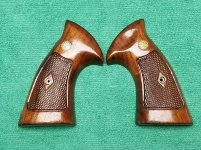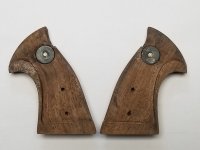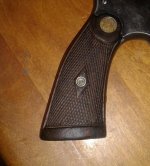AtTheRange
Member
In my last (and very first) post, I introduced you to my inherited #19 made in the last quarter of 1958.
I was told to get rid of the horrid finish on the stocks. Well, I went to my first gun show last Saturday and yep, these are horrid.
I did the initial stripping with acetone and much came off so, I'm guessing I was dealing with old varnish. However, after that, it still looked like there were patches of something else the acetone didn't touch. So, I used Jasco paint/epoxy stripper on them, and that didn't seem to help at all.
I was going to refinish them with polyurethane but, a little voice in my head said: "Have some respect for what you're working on! Take another chill pill and do some more research."
This probably comes from seeing a YouTube video of a polyurethane-finished grip looking like it's made of plastic (although very pretty).
I just spent hours surfing the S&W forum while doing searches on grip refinishing. I came across a couple of tutorials that I copied over to a word document; including the pictures. Now I get why they use Tung oil. This is what I'd like to use as well but, I'm concerned that there is still some kind of finish imbedded in the wood.
It was also suggested that these are not the original stocks because they look like they're made of walnut. I have a copy of the Standard Catalog of S&W (issue #3 I think) and they sure look like the original cut to me? I've seen posts that say walnut 'was' also used in the late 50s and early 60s.
Pictures are posted for your viewing pleasure. The first one is what I started with. I have three questions:
1. If there is still some kind of finish imbedded in the wood, how do I deal with it?
2. There's some brass showing thru on the medallions; any way to deal with that?
3. Is there some way to patch the small chip in the base of the one stock?
I was told to get rid of the horrid finish on the stocks. Well, I went to my first gun show last Saturday and yep, these are horrid.
I did the initial stripping with acetone and much came off so, I'm guessing I was dealing with old varnish. However, after that, it still looked like there were patches of something else the acetone didn't touch. So, I used Jasco paint/epoxy stripper on them, and that didn't seem to help at all.
I was going to refinish them with polyurethane but, a little voice in my head said: "Have some respect for what you're working on! Take another chill pill and do some more research."
This probably comes from seeing a YouTube video of a polyurethane-finished grip looking like it's made of plastic (although very pretty).
I just spent hours surfing the S&W forum while doing searches on grip refinishing. I came across a couple of tutorials that I copied over to a word document; including the pictures. Now I get why they use Tung oil. This is what I'd like to use as well but, I'm concerned that there is still some kind of finish imbedded in the wood.
It was also suggested that these are not the original stocks because they look like they're made of walnut. I have a copy of the Standard Catalog of S&W (issue #3 I think) and they sure look like the original cut to me? I've seen posts that say walnut 'was' also used in the late 50s and early 60s.
Pictures are posted for your viewing pleasure. The first one is what I started with. I have three questions:
1. If there is still some kind of finish imbedded in the wood, how do I deal with it?
2. There's some brass showing thru on the medallions; any way to deal with that?
3. Is there some way to patch the small chip in the base of the one stock?
Attachments
Last edited:











